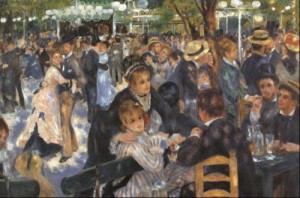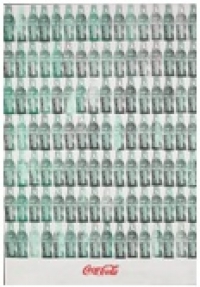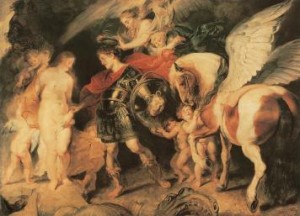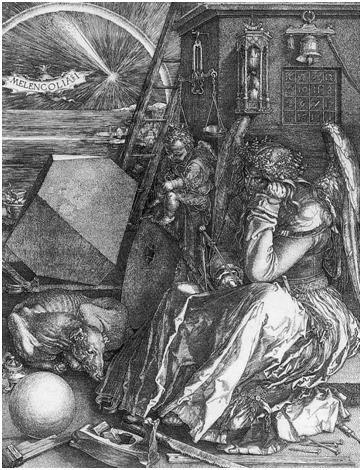Where do you go when you are looking for the latest fashion designs? Or want to see what is à la mode on the High Street? Or perhaps, just want to see what’s going on in the city? Well, the internet. Right? Or a fashion magazine.
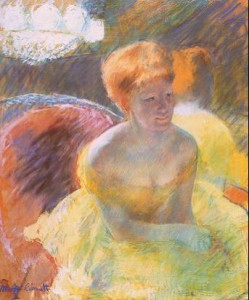
At the Theatre, c. 1879. Pastel, 53.3 x 43.2 cm. The Nelson-Atkins Museum of Art , Kansas City, Missouri.
I think that if we were to be suddenly transported to the 19th Century we would be in for a big culture shock! No internet, no modern conveniences…and yet, society of the 19th Century, in some respects, is considered to be more cultured and sophisticated than our own. More genteel, certainly! Impressionists such as Renoir, Cassatt, and Monet: these were the people who were responsible for providing society with images of the latest fashion trends. Cassatt, for example, painted theatre-goers. The who’s who of Paris fashion attended these soirees, so it is not far out of the realms of possibility that these paintings would be consulted by the fashionably elite to check out what was being worn, where and by whom…remind you of any of our celeb magazines now?
Pierre Auguste Renoir was busy capturing life in the moment – the lively scene in the ‘ball at the moulin de la gallete’ is so busy, you can practically see the movement and hear the buzz of conversation. The impressionists were offering an alternative to the black and white photography of the day. It was not a direct competition, but what they could do that the photographers couldn’t was to offer a subjective, colourful view of day to day life.

Woman with a Pearl Necklace in a Loge, 1879. Oil on canvas, 81.3 x 59.7 cm. Philadelphia Museum of Art, Philadelphia
Final thought before I finish: In their day, the Impressionists were viewed contemptuously by the members of the jury of the Salon. Their work was rejected and ridiculed due to the colours that they employed and the thick brushstrokes that they used. Mary Cassatt was even criticised for painting her subjects too realistically to be flattering. This makes me wonder – we now rely on the Impressionists’ work for a sense of the culture, fashion and way of life in the 19th century. In another couple of centuries, are today’s paparazzi going to be admired as much as we admire the Impressionists? Because, let’s face it, they too offer a glimpse into culture, celebrity fashion and day-to-day activities. They are also not highly regarded by many people in today’s society… so you see, there are links to be made between the two!
For a broader look into 19th Century life and fashion, check out the ‘L’impressionisme et la mode’ exhibition at the Musée d’Orsay, being held between the 25th September 2012 and 20th January 2013. Or, if you just want to be enchanted by a simpler time and appreciate the elegance and gentility of the 19th Century from the comfort of your technologically advanced home, take a look at Nathalia Brodskaya’s Impressionism.
Andy Warhol is easily one of the most interesting people to have ever lived. I say this having known next to nothing about him other than his over-exposed, colourful reproductions of 1960s-1980s popular culture, all of which I found excessive, superficial, and ridiculous, up until two hours ago.
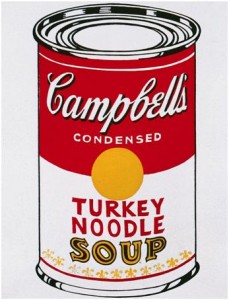
Screened in accordance with Warhol’s long-time lunchtime devotion to the brand. Andy Warhol, Campbell’s Soup Can (Turkey Noodle), 1962. Silkscreen ink on canvas, 51 x 40.6 cm. Sonnabend collection.
But wasn’t that essentially his intention, to explore popular culture? Spending most of his time at home as a young child and teenager, Warhol listened to the radio (and the adverts) and collected photos of film stars; he was greatly influenced by the growing popular culture of the 1950s. Starting his career as a commercial illustrator should come as no surprise to anyone, nor should the fact that, unlike other artists, he basked in the spotlight of fame that came from the success of his commercial art.
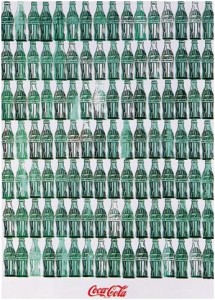
Screened for his appreciation of the wide-spread appeal of Coca-Cola – for the rich as well as the poor! Andy Warhol, Green Coca-Cola Bottles, 1962. Synthetic polymer, silkscreen ink, and graphite on canvas, 209.2 × 144.8 cm. Whitney Museum of American Art, New York.
Endlessly and un-sarcastically praising the plasticity of Hollywood, I’m convinced all Warhol wanted was his “fifteen minutes of fame” (did you know he coined that?). Little could he have ever imagined we’d still be fawning over his bright colours, cow motifs, and his Pope of Pop-(Art)dom over twenty years after his death. Though I think he’d be less impressed with the reality of what “fifteen minutes of fame” has afforded us by way of reality television (Jersey Shore and Honey Boo Boo, anyone?).
What are you waiting for? Get over to the Met now through year’s end to see Sixty Artists, Fifty Years and relish in the expansion of Pop Art over the years. Then, get these ebooks for a little at-home inspiration: Warhol by Eric Shanes and Warhol by Gerry Souter.
-Le Lorrain Andrews
When you think of “Pre-Raphaelite”, what comes to mind? For me, it is male painters, female subjects, a lot of nature, and vivid colours. And for 95% percent of paintings produced by this movement, this is the reality.
The key members of the group (Hunt, Millais, the two Rossettis, Collinson, Stephens, and Woolner) were all men. Together, they created a secret group called the Pre-Raphaelite Brotherhood. Like just about every other artistic movement, the Brotherhood wanted reform. They rejected the academic styles of Raphael and artists after him, finding them idealised and corrupted. The Brotherhood sought a return to the Pre-Raphael Italian style with its vivid colours and imitation of nature.
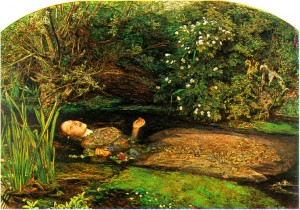
Sir John Everett Millais, Ophelia, 1851-1852. Oil on canvas, 76.2 cm × 111.8 cm. Tate Britain, London.
The Pre-Raphaelites insisted on painting nature from direct observation to ensure it was depicted with accuracy and detail. Millais even stood outside for four months painting the background of one of the most well-known paintings of the movement, Ophelia (above). After he painted the landscape, he had the model for Ophelia lie in a full bathtub in his studio. But who was this model whose face is now so well-known? Her name was Elizabeth Siddal, and she eventually became a Pre-Raphaelite artist as well, which brings us to the exceptions to the 95% rule I mentioned earlier: the female artists who successfully joined the “brotherhood.”
Elizabeth Siddal was one of several model-turned-artists of the Pre-Raphaelite movement. She was a model for almost all of the members of the Brotherhood, and was the primary subject of Rossetti (who was said to have painted Siddal thousands of times). It’s no surprise that Rossetti and Siddal became lovers and eventually married. Rossetti taught Siddal to paint; she caught on quickly and developed her own unique style. Her self-portraits (see below) are interesting because one can compare how she perceived herself as opposed to how she was perceived by the artists she modelled for. Her other paintings (such as The Ladies’ Lament, below) are characteristic of the Pre-Raphaelite movement, with their focus on nature, vivid colours, and realistic subjects.
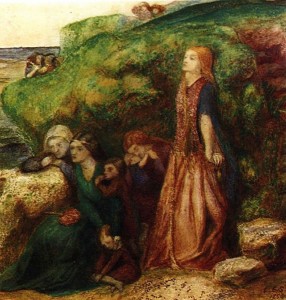
Elizabeth Siddal, The Ladies’ Lament, 1856. Watercolour on paper, 241 x 229 mm. Tate Britain, London.
Siddal was not the only female Pre-Raphaelite artist. Another notable woman from the movement was Rosa Brett, who was taught to paint by her brother, John Brett, and focused on painting landscapes. In fact, there are at least twenty others. Several of them, including the celebrated Jane Burden Morris, were also models-turned-lovers-turned-artists like Siddal.
Although these 19th century women did not have access to their own formal art education, they found other ways to learn. Luckily for them, the Brotherhood was actually quite forward-thinking in their attitude towards female painters, who they welcomed into their circle. Despite the implied gender in the name, the Pre-Raphaelite Brotherhood was a movement that enabled women to pursue their passions and do more than just pose for paintings. Women were finally beginning to establish themselves in the artistic world.
If you are in London before January 13, 2013, make sure to check out the exhibition on the Pre-Raphaelites at the Tate Britain. You may be distracted by the amazing paintings by the Brotherhood, but keep your eye out for the 5%—the ones done by the women. If you can’t make it to the exhibition or just want to learn more about this movement, check out our ebook.
You know what one of my favourite movies of all time is? Closer. It’s dark, it’s dirty, it’s intimate, it’s lonely, it’s sad, it’s beautiful, it’s true. “Anna’s” photography exhibit is one I would have visited again and again – you know, if it had been real – especially the image of “Alice”. What other artist makes me feel all of the same emotions? The Impressionist/Realist, Gustave Caillebotte.
Caillebotte’s On the Pont de l’Europe (below), to me anyway, represents a man that has lost something near to him, whether he threw it away or it crumbled into a pile of rubble, the point is that he stands alone on this bridge viewing the Saint-Lazare train station in the cold while others pass him by. When else does one notice the rivets and girders of a bridge than when they’ve got nothing left to see but the smallest things in front of them? I guess that’s what “missing the forest for the trees” hints towards, but sometimes you need to start with the smallest details and work your way out – out of your head, out of the forest, just out.
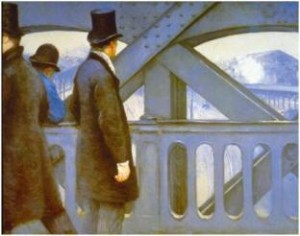
Gustave Caillebotte, On the Pont de l’Europe, 1876–1877. Oil on canvas, 105.7 x 130.8 cm. Kimbell Art Museum, Fort Worth.
And this woman? She’s had a long day at a dead-end job she despises; she comes home and just wants to enjoy being nude in her own space, all the while wondering if her partner is having an affair with their secretary.

Gustave caillebotte, Nude on a Couch, c. 1880. Oil on canvas, 129.54 x 195.58 cm. The Minneapolis Institute of Arts, Minneapolis.
Haven’t we all been here? Maybe not staring at the Saint-Lazare or wondering about our significant others having affairs, but alone in the sense of lonely not just by one’s self. Haven’t we all watched raindrops trickle down a window sill or stared idly at a wall or telephone waiting for one of them to do something? Perhaps we’ve channelled Bridget Jones, drank a half a bottle of wine, and sang loudly to ourselves? I’m not saying I’ve done one or all of these things, but you can’t deny you’ve been there.
Visit the Schirn Kunsthalle Frankfurt to see Caillebotte’s realistic, beautiful, and sometimes sad images from 18 October through 20 January 2013 and realise everyone has days like these. If you’d rather focus on the happier and brighter side of life though, check out this airy and colourful ebook on Impressionism.
-Le Lorrain Andrews
When I open any magazine these days, I look at the photos of waif-like women with perfect skin, hair and teeth, without a jot of cellulite to be seen, and it’s what I expect to see. I admit it! The world of mass media has done its work very well indeed. There is perhaps a handful of women who may be naturally blessed with the genetic make-up to look as flawless as those pictured on billboards without the help of Photoshop. And that’s just it; technology such as Photoshop gives me expectations. If I were to see an ad with the models remaining unaltered, I would be surprised. It’s human nature. To want to look better than we actually do, to make something or someone seem perfect and – with the right product or right clothing – to attract others to the same level of perfection. And then it struck me, this is not a new concept. When I look back at artists from the Renaissance and Baroque period, they do exactly the same thing. (With paintbrush and easel instead of computer and mouse.)

Peter Paul Rubens, Portrait of Susanna Lunden (?) (‘Le Chapeau de Paille’), probably 1622-1625. Oil on wood, 79 x 54.6 cm. The National Gallery, London.
Take a look at some of Peter Paul Rubens’ work. Although the curvier female form was highly admired and painted as it was – childbearing hips and all – Rubens still goes on to use the power invested in him as an artist to present the world with an interpretation of the model and the setting, rather than the real thing (or so I presume, having not been present at the actual time of painting.) In the painting of Susanna Lunden, thought to be a marriage portrait, Rubens’ use of clear and stormy skies to create light and shadow is a way to illuminate the face and much of the upper torso. In other words, she is glowing! Now, if that isn’t a tactic to make someone look more presentable, I don’t know what is!
During this thought process, my brain suddenly went into overdrive, and I began seeing links with modern culture everywhere in Rubens’ paintings. One notable comparison that my oh-so-logical self came up with is the popular past-time of photobombing. You know, you take a picture and when you look back at it, you notice that there’s an unusual face or activity happening in the background? Well, I don’t know about you, but I see a big photobomb in Rubens’ Perseus and Andromeda. My suspicions that Rubens had a sense of humour in his painting were confirmed by this painting. At first glance it looks like a romantic, serious painting. Okay, now look at the shield Perseus is carrying. Look at the expression on Medusa’s face! You heard it here first, Rubens was a photobomb master! (Or should that be paintingbomb?)
If you happen to be in Germany before the end of February and would like to check out more of Rubens’ works, or simply make up your own mind whether he was a paintingbomb genius, head over to the Von der Heydt-Museum Wuppertal. The Rubens exhibition will be held between the 16th October 2012 and the 28th February2013. Alternatively, if going to Germany just isn’t possible right now, check out our book on Rubens written by Victoria Charles.
-Fiona Torsch
I have long considered the artist and the mathematician to be incompatible specimens; geeks and creatives; oil and water. But artists such as Dürer, accomplished in both art and mathematics, certainly make a good case against my point of view.
German Renaissance printmaker Albrecht Dürer made significant contributions to mathematics in literature, publishing works about the principles of mathematics, perspective and ideal proportions. He succeeded at a time when other great thinkers, including polymaths Leonardo da Vinci and Piero della Francesca were thinking in new ways, combining art with mathematics as a way of expressing an ‘ultimate truth’. Nothing conveys Dürer’s capacity for combining the two like his famous engraving Melancholia I (1514):
Scholars have spent centuries analysing the truncated ‘rhombohedron’ (a kind of leaning cube shape) on the left of the image, as the exact geometry of the solid depicted is a subject of some academic debate (all of which involve ratio and angle calculations – not the typical ponderings of an arty type). ‘Dürer’s Solid’, as it is now known, is now part of a larger mathematical theory called the ‘Dürer Graph’ – his mathematical influence remains rife today.
Whatever inspired the creation this scientific art (or artistic science)? It seems the general feeling amongst the artist/mathematician hybrids is that mathematics makes art more beautiful. The ‘Golden Ratio’ for example, applied by the Ancient Egyptians for the building of the pyramids, was regarded as being ‘aesthetically pleasing’.
Does mathematics really enhance art? The jury is still out.
Get to know Dürer and a wealth of other European artists in Dürer and Beyond: Central European Drawings 1400-1700 at The Metropolitan Museum of Art, exhibiting until the 3rd September 2012. Alternatively, treat yourself to Dürer’s most influential works with this beautifully illustrated high-quality art book.
You can blame it on my being an emotional woman if you’d like, I take full responsibility for that, but when I discovered the Wallraf-Richardtz-Museum’s intention to reunite some of the pieces from the 1912 Sonderbund Exhibition of Post-Impressionism through German Expressionism, featuring Van Gogh, Cézanne, Gauguin, Munch, Picasso, Macke, Nolde, Schiele, Signac, etc., I got a bit teary-eyed.
Pieces that have been separated (and sometimes out of view) will be reunited in Cologne until year’s end. It’s reminiscent of one’s days in University and coming back so many years later (clearly not 100) to see how much you’ve changed – or in the case of these paintings and sculptures, hopefully not changed – over time. Maybe one of the girls in the paintings featured below is still alive and will turn up!
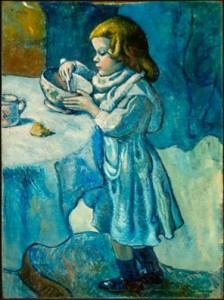
Pablo Picasso, Le Gourmet (The Greedy Child), 1901. Oil on canvas, 92.8 x 68.3 cm. Chester Dale Collection, National Gallery of Art, Washington, D.C.

Ernst Ludwig Kirchner, Fränzi in front of a Carved Chair, 1910. Oil on canvas, 71 x 49.5 cm. Museo Thyssen-Bornemisza, Madrid.
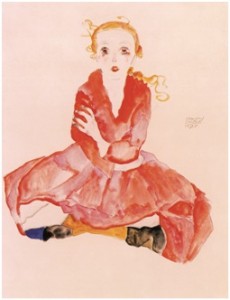
Egon Schiele, Seated Girl Facing Front, 1911. Watercolour and pencil, 46.5 x 31.8 cm. Bayerische Staatsgemäldesammlung, Munich.
There is a fear in the back of my mind, however, that in reuniting these pieces in the same city 100 years later, in a year that’s predicted to end the world, that a vortex will open up and visitors will end up in some alternate universe. Were that universe one with Schiele and friends hanging out enjoying a few glasses of absinthe, I might be keen to jump through and not look back. Sadly, I’m willing to place bets that the other side of that vortex is one of zombies without ears, boundless womanising, and crippling bouts of manic-depression – maybe not so much unlike society today. Would you jump through the vortex unknowing what you’d find?
Nevertheless, I say take the chance and do yourself a favour; book a ticket to Cologne immediately to see 1912-Mission Moderne, as this opportunity to see over 100 pieces of the wonder that was Sonderbund in one place will not come again in our lifetime. Whether you can or cannot make it, purchase these beautiful representations of the pieces on display and more in ebook form: Cézanne, Gauguin, Kirchner, Picasso, Schiele, and Van Gogh.
-Le Lorrain Andrews
Underdogs have taken note and reclaimed terms that were once hurtful or derisory: ‘queer’ has become a positive label for the LGBT community, ‘nerd’ and ‘geek’ are no longer insults but badges of honour (thanks in part to the Gleeks), ‘slut walk’ participants have tried to de-stigmatise the word, and the Tea Party movement’s ‘tea-baggers’…well, that’s a bad example. But this ‘current’ propensity for linguistic reappropriation is not such a modern phenomenon…
The Impressionists came to be known as such after a 10-year battle for recognition. In 19th-century France, artistic esteem could only be attained by recognition by the Academy of Fine Arts and the displaying of their artwork in the Salons, or yearly exhibitions in Paris. This new art movement was too mind-blowing for those stuffy old codgers – Manet’s Luncheon on the Grass didn’t make the grade because of the daring inclusion of a stark-naked lady frolicking at a picnic. I can’t imagine what they would make of Prince Harry’s trip to Las Vegas…
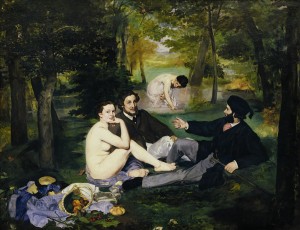
Reconstruction of Prince Harry’s trip to Vegas… Edouard Manet, Luncheon on the Grass, 1863. Oil on canvas, 208 x 264.5 cm. Musée d’Orsay, Paris.
A brief glimmer of hope came in 1863 when Napoleon III, shocked by the quality artwork that was being sidelined, opened an exhibition alongside the official Salon, an Exhibition for Rejects. This group of artists received more visitors than the official Salon, but most came along for a good chuckle at these deluded ‘artists’ and their strange paintings. Requests for another exhibition were denied, until in 1874 they decided to take matters into their own hands…
Thirty artists including Monet, Renoir, Pissarro, Sisley, Cézanne, Degas and Morisot participated in a private exhibition, which was still too zany for many. Louis Leroy wrote a sarcastic, satirical review, coining the term ‘Impressionists’ as a play on words of the title of Monet’s painting Impression, Sunrise. The term caught on, and what was meant to be a moniker of derision became a badge of honour for the group. And Leroy must have been laughing on the other side of his face when Impressionism spread beyond France, paving the way for Modern art, and even becoming the long-lasting legacy of 19th-century French art.
So take a leaf out of the Impressionists’ book and wear those insults with pride. My suggestions for some topically beleaguered individuals include: Prince Harry – ‘The Naked Prince’, Todd Akin – ‘The Legitimator’, and I’m sure Julian Assange could put a positive spin on ‘coward’, ‘tool’ or ‘cyber terrorist’.
Sweden’s Nationalmuseum has an exhibit dedicated to 19th-century France and the beginning of the Modern era, until 3 February 2013. If you would like to read more about the peppy Impressionists, try this impressive art book or compact gift version, written by Nathalia Brodskaya.
What do you think of when someone mentions the Middle Ages? I’d say caves, toga-like clothing, candles, definitely a lot of candles, witches, the burning of said witches, and ceaseless devotion to God. Often, when the internet in my apartment isn’t working, I tell friends “I’m living in the Middle Ages” – which has more candles than devotion to God and witch burning.
Honestly, let’s face it, what else was there to do between the 5th and 15th centuries aside from worship God, be a witch or burn them, participate in the many crusades, and wait to meet your maker? If you think about it, maybe part of the reason life expectancy was so short is because it is actually possible to die of boredom*.
People talk about time machines and how incredible it would be to go back (or forward, for that matter) in time, but we’re living in the best time to be alive. We’ve got television and Batman; internet and Ryan Gosling. I wouldn’t have survived ten minutes in the Middle Ages, but would happily see how those that did, entertained themselves.

The Rheims Missal (Missale Remenense), The Creation of the World, 1285-1297. Parchment, Latin, 23.3 x 16.2 cm. Paris.
The Getty is at it again, exhibiting religiously charged images, starting this month through 3 February 2013 (assuming the world doesn’t end first and we meet the Powers that Be in person): The Art of Devotion in the Middle Ages. Often find yourself without internet or electricity, or do you simply want to go back in time? Procure this fantastic representation of manuscripts of the period: Illuminated Manuscripts.
*Research was still being conducted at time of posting.
I’m going to take this opportunity to get back on my high horse about the restoration and conservation of art for posterity’s sake. J. Paul Getty Museum, you’re doing it right!
Maerten van Heemskerck, a 16th century Netherlandish painter, bestowed Ecce Homo upon us, a masterpiece which usually resides in Warsaw, but has travelled all the way to Los Angeles – maybe not the first place I’d go after leaving Warsaw; however, definitely a site to see. A curatorial team and group of scientists have spruced it up, preserved it further, and learned more about it than has been known before. Not only has nothing but good come of this, but it is further ensured to stick around for many, many more years to come.
Two similar artists from this era also deserve equal honour and praise. Think of the many hours, days, months, even years Van Heemskerck, Hieronymus Bosch, and Hans Memling put into their notable and impressive altar pieces. Shouldn’t we, as a world-class, preservationist society make every effort to make sure our children, children’s children, and etc. are able to learn about these works of art and travel around the world to see them in their permanent homes? Personally, I’d be quite keen to see where Bosch created all of his glorious and damning images – though I’m sure that’s nearly impossible considering it was so very long ago and so little is known about his actual life.

Hieronymus Bosch, Terrestrial Paradise and Ascent of the Blessed to the Heavenly Paradise, after 1490. Oil on panel, each panel: 86.5 x 39.5 cm. Palazzo Ducale, Venice.
I would be devastated to learn that the beauty and wonder of the Paradise-like afterlife presented here had deteriorated beyond recognition, though I could deal with the authenticity of some fading. More so, I would be distraught at the loss of the pure and virginal women represented in Memling’s Annunciation (below). Forget Black Widow, this Halloween I’m dressing as the angel on the left – perhaps without the book of scripture.

Hans Memling, The Annunciation (exterior shutters of a triptych), 1472. Oil on panel, shutters each 83.3 x 52.9 cm. Groeningemuseum, Bruges.
However, is there such a thing as going too far? Do we reach a point of restoration in which the piece no longer projects any part of its original skin, so to speak, and is therefore no longer, the masterpiece it once was? Are we, ultimately, destroying art for art’s sake in an entirely different way, turning it into a paint-by-numbers?
Check out Ecce Homo in its newly restored glory at the J. Paul Getty Museum though 13 January 2013. Also see many more of Memling and Bosch’s masterpieces in these ebook and print editions: Hans Memling and Hieronymus Bosch.
-Le Lorrain Andrews
By Category
Recent News
- 04/03/2018 - Alles, was du dir vorstellen kannst, ist real
- 04/03/2018 - Tout ce qui peut être imaginé est réel
- 04/03/2018 - Everything you can imagine is real
- 04/02/2018 - Als deutsche Soldaten in mein Atelier kamen und mir meine Bilder von Guernica ansahen, fragten sie: ‘Hast du das gemacht?’. Und ich würde sagen: ‘Nein, hast du’.
- 04/02/2018 - Quand les soldats allemands venaient dans mon studio et regardaient mes photos de Guernica, ils me demandaient: ‘As-tu fait ça?’. Et je dirais: “Non, vous l’avez fait.”

